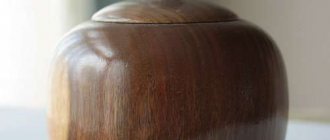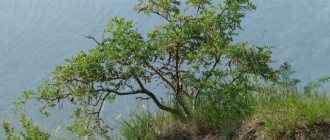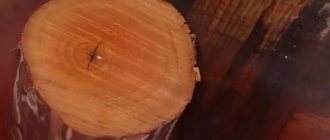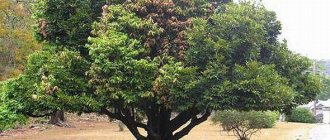Surely, many people know that hard wood is distinguished by such wood species as oak and ash. However, if we talk about the hardest wood, then it is “iron” wood. Moreover, in different countries of the world, different types of trees are classified as “iron”, distinguished by such hard and durable wood, which is often capable of surpassing iron in these indicators. This means that the wood of such trees is very difficult to process, does not float on water and sinks, and can also be used to make nails and even structural elements for cars. So which representatives of the plant world have the well-deserved title of “the hardest tree”?
Temir-agach
This hardest tree is present in the forests of Azerbaijan and Iran. In terms of hardness, it is many times stronger than iron. If you want to walk through thickets of such trees, you will very soon realize that this is impossible due to the lack of flexibility of their trunks. Very often, such trees are used to make hedges, which grow stronger and stronger every year.
Parrotia
This is the hardest tree among the “iron” ones and is found in the forests of Northern Ireland and Transcaucasia. The black wood has an unusual structure, is very durable and is resistant to various insect pests. Due to the high density of parrotia wood, it is successfully used for the production of wind musical instruments, machine parts and various artistic crafts. This tree is included in the Red Book.
Where does the iron tree grow?
Ironwood wood is very durable, heavy and hard (density 0.9-1.05 g/cm3), its properties resemble boxwood, it is used locally as a structural and ornamental material (used for the manufacture of some machine parts, art products, decorative plywood) .
Grows in relict broad-leaved forests of Azerbaijan (Talysh) and the northern part of Iran (southern coast of the Caspian Sea) in the lowlands and in the mountains (up to 700 m above sea level, sometimes higher), along the banks of rivers, streams, in gorges in highly humid areas, less often - on dry rocky soils.
Other plants with hard wood are also called ironwood: Musa ferrea (India), Ixora ferrea (Antilles), Caesalpinia ferrea (Brazil), Stadmannia sideroxylon (O.
Mauritius), Argania sideroxylon (Morocco), some species of the genus Sideroxylon, etc.
Tiss
This representative of the “iron” trees not only has super-strong wood, but also does not rot, which is why it received the name “non-iron tree”. Found in Transcaucasia and the Far East. In the past, the wood of the “slender wood” was used to make nails and was also used to build structures located under water or underground.
Other representatives of the group
In addition to such popular species belonging to the “iron tree” group, there are many other “stone” plants. They grow on different continents and amaze with their strength, as well as unique healing properties. These include the following breeds:
- Yew. Wood can retain moisture, but it does not rot.
- A Christmas tree found in New Zealand. There are entire groves of such trees in this area. They only throw out the blossoms at Christmas.
- Hop Grab. The climate of the subtropical zone suits it, so hop hornbeam grows just above the equator. Sadly, only fossilized remains of its wood have been found in Russia.
- Mezuya. Asian peoples use the poisonous resin of this plant as a medicinal drug.
- Brazilwood. The endangered species grows in the Amazon jungle in Brazil.
- Guaiacum. It grows on islands located in the Caribbean. The resinous substances of this tree are used as stimulants.
As you can see, there are exceptions to the rules not only in linguistics, but also in nature. Such “iron” trees are an example of this. They have unusually strong wood that is unable to float on water.
Birch Schmidt
This is the hardest tree growing in a protected forest called “Kedrovaya Pad” (Primorsky Territory). The strength exceeds the same parameter of cast iron by 1.5 times. You can even shoot this birch tree with a pistol - the bullet will simply fly off and not damage its trunk. The wood of this tree successfully replaces metal. The rare tree lives for about four hundred years, which is a very impressive life span, because not a single birch tree is distinguished by such longevity.
Iron trees
Often, in order to emphasize the hardness of a material, we compare it with iron, but not everyone knows that in the subtropics and tropics there are trees whose wood is as hard as iron. This tree grows in the Talysh Mountains in southern Azerbaijan. It is called Temir-Agach, translated this word means “iron tree”. Its branches and trunk are distinguished by an uncharacteristic rust color. But wood is actually very hard and heavy, like iron, and even sinks in water.
However, a more unique property of this tree is the fact that its trunks and branches grow together, thereby forming impenetrable thickets. That is why temir-agach is used for the construction of fences and gazebos, which will never require repairs and will become stronger every year. The wood of this “iron tree” is used to make parts for instruments, shuttles for textile machines and some musical instruments.
Nature has endowed the “iron tree” with another unique property. In the Talysh forests in the autumn there is an opportunity to hear some incomprehensible chatter. This is how the Temir-Agach tree shoots. During this period, its seeds scatter from their capsules over a distance of about eighteen meters, and are removed from the trunks and foliage of trees.
In the southern part of the Primorsky Territory there is a similar tree, but it does not shoot its seeds from the capsules. It is called Schmidt birch, and local residents nicknamed it “iron birch” because it is almost one and a half times stronger than cast iron. And if you shoot a bullet into its barrel, it will fly off and leave no mark on the tree.
There is another “iron tree”, which has very heavy and hard wood, it grows in such South American republics as Argentina and Paraguay. This type of brother-in-law in this area is nicknamed quebracho; translated from Spanish it means “break the axe.” A very eloquent name, isn't it?
A unique shrub grows on several peaks of the Kopetdag mountains, which are located near the border of Iran and Turkmenistan. Its closely intertwined stems form something like huge pillows. But they cannot be useful for sleeping, because they are so hard that even horses’ hooves do not leave marks on them. If you set fire to these “green pillows”, they burn with a very bright flame. An interesting fact is that such shrubs also grow in another desert region of South America, and more specifically in Patagonia, that is, on the opposite hemisphere.
Ulin
This Bornean “iron” wood is extremely difficult to process due to the high hardness of the wood. Its smooth texture and pleasant color make ulin especially attractive in the production of parquet, solid boards and furniture. You can cut this tree, but you often have to sharpen your tools. But a product made from ulin will last quite a long time.
What is ironwood
F. is also called other plants with hard wood: Musa ferrea, Ixora ferrea, Caesalpinia ferrea, Stadmannia sideroxylon, Argania sideroxylon, some species of the genus Sideroxylon, etc.
Iron tree - Persian parrotia (Parrotia persica), temir-agach (Azerbaijani), deciduous tree, sometimes reaching 25 m or more with a trunk diameter of up to 90 cm. It is distinguished by very beautiful and exceptionally hard wood, which is why it is often called iron tree.
The trunk sometimes branches all the way to the ground, the branches often take root and grow together and with the branches of neighboring trees (hornbeam, zelkova, maple, etc.). The bark is gray, sometimes reddish-brown, flaking. The leaves are leathery, obovate or elliptical. Persian parrotia lives up to 200 years.
Persian parrotia is a kernel-free species with pale pink wood, which over time acquires brownish tints. The annual layers are poorly visible; the medullary rays can only be distinguished in a radial section.
White acacia
This tree has wood that in our country is considered one of the hardest. Attractive texture, rich color, excellent strength, highest hardness, remarkable resistance to rotting - these are the distinctive features of this wood. In addition, it is very easy to polish. Acacia wood is used for the production of furniture and parquet.
Characteristics of wood
Iron trees are distinguished by a unique trunk structure and a number of other parameters given below:
- The bark contains tannins that help resist the appearance of fungal diseases and various parasites.
- The fibers of the barrel are resistant to acids and are resistant to corrosion.
- The age process reaches the 200-year mark and is capable of further growth.
- The density of wood is large and equal to 1 t/m³, with a humidity of 12%. Therefore, the development of aging is slowed down.
- The girth of the aksakal trunk can exceed 200 cm.
Possessing such qualities, vegetation is capable of surviving in different climatic conditions. Drought and abundant humidity do not harm powerful abilities and cannot break an iron character.
Sucupira
The wood of this tree, which grows in Brazil, Venezuela and Colombia, is difficult to work with, but polishes well. Also, sucupira wood is not susceptible to fungi and various pests. Among the trees with durable and hard wood, one can also distinguish ebony, rosewood, and kumara. All these trees sink easily in water and have rot-resistant bark. This means that you won’t be able to make a boat from their wood, but you can make beautiful furniture.
The hardest wood species: properties of wood, secrets of use
Another Central American ironwood is locally called Quebracho , which means “break the axe.” In the forests of Eastern Transcaucasia you can find thickets of the famous ironwood, or Persian parrotia . It's quite difficult to get through them. In contact with each other, the trunks of neighboring trees grow together and form intricate interlacings - the so-called “drunk forest”. It is especially interesting in autumn, before leaf fall, when parrotia leaves turn purple.
Persian parrotia (Parrotia persica)
The shiny black seeds of the ironwood tree are found in small, durable pods. During ripening, the boxes burst open and the seeds fly out with a crash at a distance of at least 10 meters from the mother tree. Agile "shooters" are the champions of subtropical forests in terms of "shooting" range. Ironwood wood is very durable. True, she is inferior to the tropical champions, but it is not difficult to break an ax on her. Weaving shuttles are made from strong parrotia wood.
There are such trees on other continents. In Africa these are Argan sideroxylon and Butyrospermum Parka . In Asia there is the famous teak tree , which produces wonderful ship wood. The Indo-Malayan region is home to an ironwood called mezua , which has the widest range of uses.
Its durable wood is used to make railway sleepers, and its delicate and fragrant flowers are highly valued in the perfume industry.
Tropical trees from the ebony family are known for their hard and beautiful wood. The wood density of these trees, especially blackwood persimmon, is very high - more than 1.32 grams per cubic centimeter.
Durable wood has a uniform structure, and the growth rings are not visible in it.
, stone birch grows . Its bark is dark gray and shaggy, and its wood is extremely hard and durable. There is also an iron birch growing in the Far Eastern taiga. Its bark is dark purple, almost black when old, and the wood is not only dense, like iron, but also so heavy that it sinks in water. And if you shoot at it, the bullet bounces off the barrel like a pea off a wall. The best ax hits this birch without causing any harm.
Iron birch is not inferior in strength not only to many metals, but also to the recognized “champion of hardness” - tropical buckout ironwood .
Iron birch is used to make such particularly strong parts as the sliders of weaving shuttles. It is used in all cases where a product of high reliability and strength is required.
Stone birch, Hortus Haren botanical garden, Groningen province, The Netherlands
Tags: guaiacum, quebracho, parrotia persica, argan sideroxylon, butyrospermum parka, teak wood, mezua, stone birch











